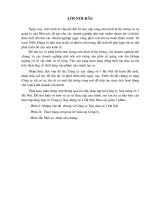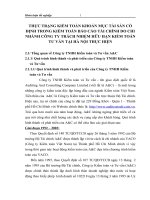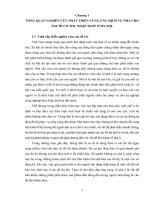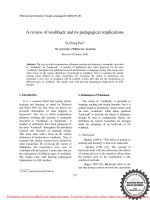Báo cáo "A study of waste water impacts of main factories on water quality of To Lich river, Ha Noi " doc
Bạn đang xem bản rút gọn của tài liệu. Xem và tải ngay bản đầy đủ của tài liệu tại đây (45.94 KB, 5 trang )
VNU Journal of Science, Earth Sciences 26 (2010) 174-178
174
A study of waste water impacts of main factories on water
quality of To Lich river, Ha Noi
Tran Van Quy*, Tran Van Son
Faculty of Environmental Sciences, Hanoi University of Science, VNU, 334 Nguyen Trai, Hanoi, Vietnam
Received 9 September 2010; received in revised form 11 October 2010
Abstract. Waste water from industrial sites amounts to one third of total waste water discharged
into To Lich river, and may have serious effects on the river water quality. With the total amount
waste water of factories (Hanoi beer alcohol and beverage joint stock corporation (HABECO),
Trang An JSC and Thuong Dinh industrial park) of 45,000 m
3
/day, these factories accounts for
more than a half of total industrial waste water released into To Lich river. The analytic results of
water samples taken from To Lich river show that the parameters of DO, COD, BOD
5
, TSS, NH
4
+
,
NO
2
-
and coliform exceed the Vietnamese Standards (QCVN 08:2008, column B
2
). However, the
concentrations of Fe and heavy metals (Zn, Cd, Cr, Cu, Mn), are lower than the Vietnamese
Standards (QCVN 08:2008, column B
2
), except the concentration of ion Pb, especially in the area
from Thuong Dinh Industrial Park to the last segment of the river. The analytic results of waste
water from the main factories (HABECO, Trang An JSC and Thuong Dinh industrial park, Hanoi
Soap Joint Stock Company (HASO); Saovang Joint-stock Rubber Company (SRC); Tool No.1
Joint-stock Company (TJC)) show that, the parameters of TSS, BOD
5
, COD, total of nitrogen,
total of phosphorus are higher than the Vietnamese standards for Industrial waste water QCVN
24:2009/BTNMT (column B). In particular, all waste water parameters of Trang An JSC are lower
than the Vietnamese Standard for Industrial waste water QCVN 24:2009/BTNMT (column B),
because the factory has an effective waste water treatment system. The heavy metals parameters of
waste water from all factories are lower than QCVN 24:2009/BTNMT. Estimated loads of
contaminants in waste water from the factories by load coefficient of IPC software show that
without treatment, HABECO can release 1974 tons of BOD, 766 tons of TSS, 8.4 tons of
phosphorus and 52.5 tons of nitrogen annually; Trang An JSC can release 64.8 tons of BOD, 48.6
tons of TSS, 0.6 ton of phosphorus, 1.6 tons of nitrogen and 25 tons of oil and grease; HASO
releases 30 tons of BOD, 33 tons of TSS and 5 tons of oil and grease. Thus, if the waste water is
not treated, it can lead to a very seriously pollution for To Lich river.
Keywords: To Lich river, sewage, IPC (Intergrated Pollution Control) software.
1. Introduction
∗
Recently, there have recently been many
studies of status of water quality and solutions
of To Lich river. However, there is not much
data surveys and impacts assessment of sources
_______
∗
Corresponding author. Tel.: 84-4-35580515.
E-mail:
affecting to water quality of the river, especially
industrial waste water. These sources account
for more than one-third of total volume of
waste water of To Lich river (about 70.000 –
75.000 m
3
/day) [1], but industrial waste water
containing toxic compounds are cumulative of
heavy metals or persistent organic biologocal
compounds, research of waste water will
positively contribute to the understanding of
T.V. Quy, T.V. Son / VNU Journal of Science, Earth Sciences 26 (2010) 174-178
175
pollution status and sources. Since then, the
proposed measures can help to manage the
water quality of To Lich river.
2. Materials and methods
To study the influence of waste water from
some main factories on water quality of To Lich
river, in this research findings previous studies
of river water quality were collected and
synthesized. Then field surveying, site selecting
and sampling the river’s water and industrial
waste water from some main factories to
analyze and compare. The water samples were
preserved and analyzed in the Laboratory of
Environmental Analysis, Faculty of
Environmental Sciences, Ha Noi University of
Sciences, VNU in accordance with the
Vietnamese standard methods. Analytic
apparatus, including machine atomic absorption
spectrometry (AAS 6800, Japan), UV-VIS
Spectrometer, and a number of common
laboratory instruments and equipment are used.
From the analytic results of waste water
components and data about flows from the
factories, the pollutants loads are calculated
(based on the parameters of software IPC -
Integrated Pollution Control) [3] and the impact
of this waste water on To Lich river water
quality is assessed.
3. Results and discussion
3.1. Current Status of To Lich river water quality
According to the analytic results of river
water samples, To Lich river is generally very
polluted especially in the dry season. In rainy
season, although pollutants water have been
diluted but it still does not ensure
environmental hygiene. In particular, DO value
increases from upstream to downstream river;
BOD
5
value at the Hoang Quoc Viet Street and
Cau Moi (Nga Tu So) are the lowest in the
rainy season, respectively about 35 and 33mg/l,
while that in Thuy Khe in the dry season is the
highest (68mg/l), COD is 65–91mg/l (dry
season) and about 50–74 mg/l (rainy season).
Ratio between BOD/COD decreased gradually
from upstream (0.78 mg/l) to the downstream
side (0.65 mg/l).
TSS in river water is rather high from 69 to
135 mg/l. Ammonium concentration in the river
is very high (approximately the lowest is 2
times and the highest is 8.3 times higher than
with QCVN 08:2008, column B
2
). NO
2
-
concentration varies between 0.120 to 0.863
mg/l, higher than QCVN 08:2008, column B
2
(0.05 mg/l). Coliform beyond permissible limits
in all samples (from 7 to 25 times) varies from
6.9*10
4
to 2.5*10
5
MPN/100ml.
pH value and concentrations of Fe and
heavy metals (Zn, Cd, Cr, Cu, Mn) in all
positions lie within the limit permitted under
QCVN 08:2008, column B
2
. However, Pb
levels exceed permissible limits in some parts
of the river, which flows through the Thuong
Dinh industrial zone and river sites are
influenced by discharge of industrial activity
(0.1295 mg/l at Nga Tu So). These results are
relatively consistent with other studies’ findings
[1, 2, 4].
3.2. The composition of waste water from
factories into To Lich river
To assess the impact of waste water from
chosen factories on To Lich river water quality,
sampling and components analysis in waste
water from : HABECO (NM1); Trang An JSC
(NM2); General discharge of waste water in
Thuong Dinh Industrial Zone (NM3); HASO
(NM4) SRC (NM5); TJC (NM6) are conducted.
The analytic results are given in Table 1.
T.V. Quy, T.V. Son / VNU Journal of Science, Earth Sciences 26 (2010) 174-178
176
Table 1. Composition analytic results of waste water from some main factories
Samples of waste water from factories
Parameters Unit
NM1 NM2 NM3 NM4 NM5 NM6
QCVN 24-2009,
Column B
Temperature
0
C 29,2 29,4 28,1 28,9 28,7 29,1 40
pH - 8 7,9 6,4 8,5 8,1 6,8 5,5 – 9
TSS mg/l
200 85 160 185,3 81 115 100
N – Total mg/l 35 25 25 26 23 22 30
P – Total mg/l 5,1 5,3 5,8 5,7 5,4 5,9 6
BOD
5
mg/l at 20
0
C
250 45 70 69 81 60 50
COD mg/l 350 75 108 104 79 106 100
Fe mg/l 0,5689
0,5102
0,6421
0,6576
2,1512
1,8715
5
Cr
+3
mg/l 0,0125
0,0312
0,0625
0,0571
0,0781
0,0421
1
Cu mg/l 0,0116
0,0183
0,0541
0,0149
0,0176
0,0132
2
Cd mg/l 0,0013
0,0017
0,0054
0,0065
0,0057
0,0036
0,01
Zn mg/l 0,0172
0,0234
0,0417
0,0167
0,0453
0,0716
3
Pb mg/l 0,4110
0,2391
0,4961
0,4902
0,5012
0,4892
0,5
Mn mg/l 0,0438
0,0517
0,1319
0,1376
0,1392
0,1903
1
(Source: Laboratory for Environmental Analysis–Faculty of Environmental Sciences–Ha Noi University of Sciences - VNU).
TSS, BOD
5
, COD of almost factories
exceed the legal standards. TSS in waste water
of HABECO is the highest (200mg/l),
exceeding the correspondent standard QCVN
24:2009, column B by 2 times. TSS in the
waste water of Trang An JSC and SRC are the
lowest, respectively at 85 and 81mg/l; BOD
5
in
waste water of all factories varies from 45 to
250mg/l, and almost exceed the QCVN
24:2009, column B, except at Trang An JSC;
COD in waste water from factories is quite
high, three factories exceed QCVN 24:2009
column B, except Trang An JSC and SRC.
Total nitrogen in waste water of HABECO
exceed the permitted limit, while other factories
meet the standard. Only parameters in Trang An
JSC are standards. Because the factory has built
a relatively efficient water treatment system.
0
10
20
30
40
mg/l
NM1 NM2 NM3 NM4 NM5 NM6
factories
N-total in waste water from the factories
N-Total
Figure 1. Total nitrogen in waste water of factories.
T.V. Quy, T.V. Son / VNU Journal of Science, Earth Sciences 26 (2010) 174-178
177
The concentrations of total phosphorus in
waste water from factories increase from
upstream to downstream of the river (ranging
from 5.1 to 5.9 mg/l). In particular, total
phosphorus concentration in Thuong Dinh
industrial zone is the highest (Figure 2).
4.5
4.8
5.1
5.4
5.7
6
mg/l
NM1 NM2 NM3 NM4 NM5 NM6
factories
P - Total in waste water from the factories
P - Total
Figure 2. Total phosphorus in waste water of factories.
So, factories impact the water quality of the
To Lich River. From the factory waste water
analysis it is found that, the main pollutants in
waste water in To Lich river Watershed
(HABECO, Trang An JSC) are organic matter,
nitrogen, TSS. The concentrations of non-
biodegradable compounds, phosphorus, iron
and other heavy metals in waste water of the
factories in downstream of To Lich river
(Thuong Dinh industrial zone) are higher.
Total waste water of the surveyed factories
(HABECO, Trang An JSC, Thuong Dinh
industrial zone), is about 45,000 m
3
/day,
accounting for more than a half of total
industrial waste water discharged into the river.
Although, the waste water flow from factories
is not high compared with the main sources of
the river. Because it includes many non-
biodegradable pollutants, it can cause severe
and lasting pollution for the To Lich river.
3.3. The influence of pollutants loads in factory
waste water on water quality of To Lich river
To assess the pollutants load in factory
waste water to water quality of the river some
parameters from the Integrated Pollution
Control (IPC) software of the World Bank and
the World Health Organization applied for
developing countries were used [3].
Results show that, with current capacity the
annual pollutants loads in factory waste water
are as follows: HABECO discharges about
1974 tons of BOD, 766 tons of TSS, 8.4 tons of
phosphorus and 52.5 tons of nitrogen; Trang An
JSC - 64.8 tons of BOD, 48.6 tons of TSS, 0.6
tons of total phosphorus, 1.6 tons of nitrogen
and 25 tons of oil and grease; HASO - 30 tons
of BOD, 33 tons of TSS and 5 tons of oil
grease.
Thus, the pollutants loads in waste water by
three surveyed factories are quite high and the
T.V. Quy, T.V. Son / VNU Journal of Science, Earth Sciences 26 (2010) 174-178
178
highest is at HABECO. If this waste water is
not treated before being discharged into the
river, it will greatly affect the water quality of
To Lich river.
4. Conclusions
In most of the entire of To Lich river the
parameters of DO, COD, BOD
5
, TSS, NH
4+
,
NO
2
-
, coliform are higher than standards.
However, the levels of Fe and heavy metals
such as Zn, Cd, Cr, Cu, Mn meet the standard,
only the concentration of Pb exceeds the
permitted standards, especially in Thuong Dinh
Industrial Zone.
The quality of discharge water from
factories into rivers: the parameters such as
TSS, BOD
5
, COD, nitrogen, phosphorus in
waste water discharging into the To Lich river
from the factories (HABECO, Thuong Dinh
Industrial Zone, HASO, SRC, TJC) do not meet
the permitted standards. Only Trang An JSC
has installed a water treatment system, so its
waste water discharge meets the standard. The
concentrations of heavy metals in waste water
of the factories meet the standard.
Calculations of pollutants loads in waste
water from some factories by IPC software
show that, if not treated, the annual pollutants
loads of HABECO are about 1974 tons of
BOD, 766 tons of TSS, 8.4 tons of phosphorus
and 52.5 tons of nitrogen; Trang An JSC
approximately 64.8 tons of BOD, 48.6 tons of
TSS, 0.6 tons of phosphorus, 1.6 tons of
nitrogen, 25 tons of oil and grease; HASO
about 30 tons of BOD, 33 tons of TSS, 5 tons of
oil and grease. So, if not treated before being
discharged into To Lich River, it will cause
serious pollution to the river.
References
[1] Project “Relevant Using of ToLich river’s water
and improve environmental sanitation condition
in riverside small villages. VietNam
Environment and Sustainable Development
Institute (VESDI).2008.
[2] Nguyen Thi Bich Nguyet – Ha Noi University of
Science. Research on effects of ToLich river’s
water to running water source and air
environment in riverside small villages and
proposes control methods. 2008.
[3] The software IPC – Intergrated Pollution
Control, World Bank (WB) and World Heath
Organization (WHO), 1995.
[4] Nguyen Xuan Huan, Nguyen Quoc Viet, Hoang
Thi Quynh Trang, Nguyen Tien Trung, Le Viet
Cao– Ha Noi University of Science. Study on
the effect of domestic waste water on water
quality of To Lich river and proposed solution
process, Soil Sciences Journal (2010) 124.









